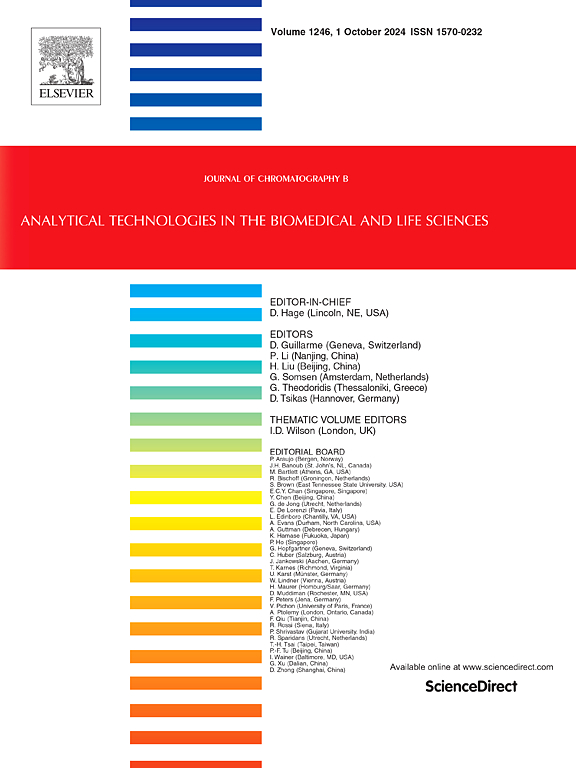Determination of glucose impurities in glucose-salt complex pharmaceutical products by HPLC-RID method: Analytical method development and validation study
IF 2.8
3区 医学
Q2 BIOCHEMICAL RESEARCH METHODS
引用次数: 0
Abstract
Pharmaceutical products containing glucose and salt are widely used in the health sector and play a vital role. These pharmaceutical products are usually encountered as a part of drugs used in treatment and medical procedures. However, the analytical determination and quantification of active ingredients and impurities belonging to active ingredients in such products is a complicated process. This is because the retention time of impurities belonging to the glucose molecule in these pharmaceutical structures and the presence of salts that give peaks in similar places complicate the analysis process. Moreover, when the British Pharmacopoeia (BP), European Pharmacopoeia (EP) and US Pharmacopoeia (USP) are examined, it is seen that there are only monographs belonging to glucose raw material and there is no record regarding the determination of impurities belonging to glucose in pharmaceutical products containing glucose-salt complex structures. A new method has been developed within the scope of the study to prevent this complexity. As a result of the method development studies, the specific solvent method was optimized and a relatively simple pre-purification process with high recovery was applied to avoid salt interference. In addition, high-precision determination and validation studies of glucose and its impurities were carried out using the High Performance Liquid Chromatography-Refractive Index Detector (HPLC-RID) method. This new analytical approach is expected to contribute to the development of reliable and high-quality products in the healthcare field by raising industry standards.

HPLC-RID法测定葡萄糖盐复合制剂中葡萄糖杂质:分析方法的建立及验证研究
含葡萄糖和盐的医药产品广泛应用于卫生领域,发挥着至关重要的作用。这些药品通常作为治疗和医疗程序中使用的药物的一部分而遇到。然而,这类产品中有效成分和属于有效成分的杂质的分析测定和定量是一个复杂的过程。这是因为在这些药物结构中属于葡萄糖分子的杂质的滞留时间以及在类似地方产生峰的盐的存在使分析过程复杂化。此外,在查阅英国药典(BP)、欧洲药典(EP)和美国药典(USP)时发现,在含有葡萄糖-盐复合物结构的药品中,只有属于葡萄糖原料的专著,没有关于葡萄糖杂质测定的记录。在研究范围内已经开发了一种新方法来防止这种复杂性。通过方法开发研究,优化了特定溶剂法,采用相对简单、回收率高的预纯化工艺,避免了盐干扰。此外,采用高效液相色谱-折光检测器(HPLC-RID)方法对葡萄糖及其杂质进行了高精度测定和验证研究。这种新的分析方法有望通过提高行业标准,为医疗保健领域可靠和高质量产品的开发做出贡献。
本文章由计算机程序翻译,如有差异,请以英文原文为准。
求助全文
约1分钟内获得全文
求助全文
来源期刊

Journal of Chromatography B
医学-分析化学
CiteScore
5.60
自引率
3.30%
发文量
306
审稿时长
44 days
期刊介绍:
The Journal of Chromatography B publishes papers on developments in separation science relevant to biology and biomedical research including both fundamental advances and applications. Analytical techniques which may be considered include the various facets of chromatography, electrophoresis and related methods, affinity and immunoaffinity-based methodologies, hyphenated and other multi-dimensional techniques, and microanalytical approaches. The journal also considers articles reporting developments in sample preparation, detection techniques including mass spectrometry, and data handling and analysis.
Developments related to preparative separations for the isolation and purification of components of biological systems may be published, including chromatographic and electrophoretic methods, affinity separations, field flow fractionation and other preparative approaches.
Applications to the analysis of biological systems and samples will be considered when the analytical science contains a significant element of novelty, e.g. a new approach to the separation of a compound, novel combination of analytical techniques, or significantly improved analytical performance.
 求助内容:
求助内容: 应助结果提醒方式:
应助结果提醒方式:


